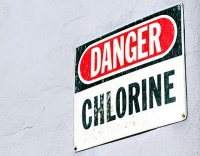Chlorine
What is chlorine?
Chlorine is a greenish-yellow, poisonous gas. It has a pungent, irritating odor. It is a very corrosive, hazardous chemical. Chlorine is not flammable, but may react explosively or form explosive compounds with many common household products like vinegar or ammonia.
What are some uses of chlorine?
Chlorine is one of the most commonly manufactured chemicals in the United States. Chlorine is commonly mixed to make products like household bleach or swimming pool shock. It is used to kill harmful bacteria in drinking water. It is used as part of the sanitation process for industrial wastewater and sewage. Chlorine is also used to make pesticides, synthetic rubbers, refrigerants, paper and cloth.
How might people be exposed to chlorine?
- If chlorine gas is released into the air from an accidental spill, people may be exposed through inhalation or through contact with skin or eyes.
- If household cleaners containing bleach are mixed with cleaners containing ammonia, chlorine gas is released and people may be exposed through inhalation.
- If swimming pool chemicals are not correctly handled, chlorine gas could be released and people may be exposed through inhalation.
- If liquid chlorine is released into water, people may be exposed by touching or drinking the water.
- If liquid chlorine comes into contact with food, people may be exposed by eating the contaminated food.
What are the health effects of chlorine?
Chlorine is a safe and effective disinfectant when appropriately used. Symptoms of chlorine poisoning vary depending on the amount of chlorine to which a person is exposed, how a person is exposed, the length of the exposure and whether the chemical is inhaled, touched or eaten. People’s bodies respond differently to chlorine exposure. People with preexisting lung or heart disease may be particularly sensitive to chlorine.
Children may receive a larger dose than adults exposed to environments with the same levels of chlorine gas because they have greater lung surface area-to-body weight ratios and increased minute volumes-to-weight ratios. Children may be more vulnerable to corrosive chemicals like chlorine than adults because of the smaller diameter of their airways and also failure to evacuate an area promptly when exposed. In addition, they may be exposed to higher levels than adults in the same location due to their shorter height, as higher levels of chlorine gas may be found closer to the ground.
The following signs and symptoms may develop during or immediately after exposure to chlorine:
- Blurred vision
- Blisters on the skin
- Burning sensation in the nose, throat, mouth and eyes
- Chest pain
- Coughing
- Fluid in the lungs
- Frostbite
- Headache and dizziness
- Nausea and vomiting
- Shortness of breath
- Sore throat
- Watery eyes
- Wheezing
Symptoms may appear immediately if high concentrations of chlorine gas are inhaled, or symptoms may be delayed if low concentrations of chlorine gas are inhaled. Death can result from a high level of chlorine exposure.
Chronic exposure to chlorine may cause corrosion of the teeth. Long-term exposure to low levels of chlorine gas is potentially related to lung diseases such as bronchitis or shortness of breath. Multiple exposures to chlorine have produced flu-like symptoms and a high risk of developing reactive airways dysfunction syndrome.
What to do if you are exposed to chlorine?
- Quickly leave the area where the chlorine was released and get to fresh air.
- If you may have been exposed, remove your clothing; rapidly wash your entire body with soap and water.
- If your eyes are burning or your vision is blurred, flush your eyes with plain water.
- If you ingested chlorine, do not induce vomiting or drink fluids.
- Seek medical attention right away. Call 911 or the Tennessee Poison Center at 1-800-222-1222.
How to reduce the risk of chlorine exposure?
- Do not mix bleach with other household cleaners because chlorine gas can be released to the air.
- Store household chemicals in their original, labeled containers and out of reach of children to prevent accidental exposure.
- Do not store chemicals in containers children would find attractive to eat or drink from, such as old soda bottles or milk jugs.
- Handle swimming pool chemicals properly to prevent chlorine gas from being released into the air.
- Read the labels of chlorinated products carefully and do not let children play with these products.
Additional resources
Tennessee Poison Center 1-800-222-1222
www.vumc.org/poison-control/home
Tennessee Department of Health
Healthy Homes
www.tn.gov/healthyhomes
Centers for Disease Control and Prevention (CDC)
Public Response Hotline 1-800-CDC-INFO or send e-mail inquiries to cdcinfo@cdc.gov
National Institute for Occupational Safety and Health (NIOSH)
Chlorine
www.cdc.gov/niosh/topics/chlorine
Agency for Toxic Substances and Disease Registry (ATSDR)
ToxFAQs for Chlorine
www.atsdr.cdc.gov/toxfaqs/tf.asp?id=200&tid=36
